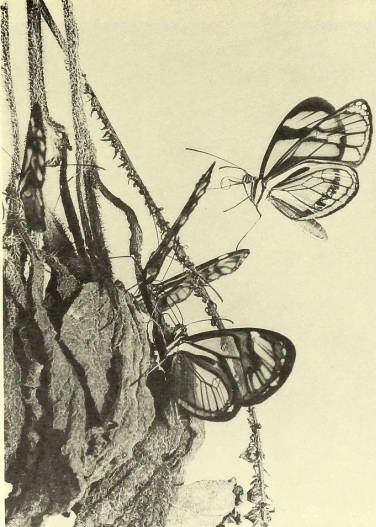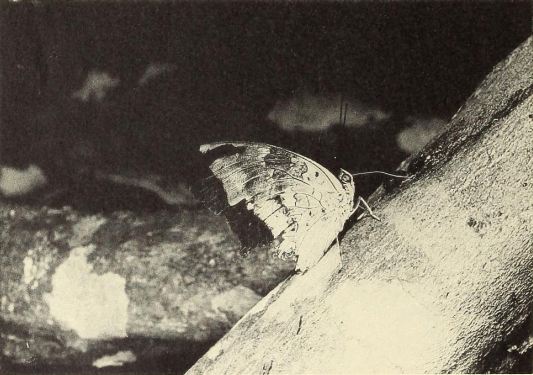At first glance I thought that the family Ithomiidae must be included in the tangerine association, but a butterfly observed on March 14 proved to be another nymphalid— Pro/ogon/Mj ochraceus Butler, tailed and of typical ithomiid pattern. Several were observed, one of which crept close alongside a preponid and fed while brushing wings with the larger species.

Historis odium orion (Fabricius) was recorded six times, comprising at least four different individuals. In brief glimpses of the orange and black of upper wings in flight it resembled a brassolid; when alighted it closely approximated Prepona.
No day passed without one, two or all three species of preponids being present, feeding upon the frothy matter. These were Prepona demophon (Clerk), Prepona antimache (Hiibner), and Prepona meander (Cramer). Owing to their swift flight among the lights and shadows it was impossible to differentiate the species on the wing, but after alighting, the under wing pattern was diagnostic. Especially was this true of meander, with the sharply demarcated halves of light and dark brown. All were seen to defend their position against encroachment by other butterflies or by beetles and flies. The tongues of preponids are pale red and seem stout enough to push and buffet aside any interfering insect. These usually wary butterflies were all exceedingly tolerant of approach, almost permitting one to touch them before taking flight.
Two individuals of the Trinidad Morpho, Morpho peleides insularis Fruhstorfer, were members of the tangerine association, coming to drink at odd times, and by sheer size and weight taking possession of some of the food areas.
Five Coconut Brassolids, Brassolis sophorae sophorae (Linnaeus), were visitors to the tangerines. Individual count was made possibly by the various degrees and positions of wing damage. Two of these insects made return visits throughout five weeks.
Two out of the three species of Trinidad Owl Butterflies or Caligos came to drink at the tangerine supply. These were Caligo eurilochus minor Kaye and Caligo illioneus saltus Kaye. These were easily identifiable on their alighting, because of their relative size, minor being appreciably the smaller. The ocellus in saltus is almost twice the size of the other. These great butterflies seldom came into contact with the others because of their crepuscular habits, arriving in early morning and in late evening.
B. Orders Other than Lepidoptera
Less attention was paid to orders other than Lepidoptera. They were few in number, both of species and individuals. All were drinking at the lesions.
1. Coleoptera
Large Green Elater, Chalcolopidius virens (Fabricius). Three were seen at feeding troughs on separate occasions. Did not seem to mind being picked up and replaced.
Large Brown Eyed-elater, Pyrophorus pellucens Eschscholtz. Two seen and captured.
Large Black Cetonia. One was captured on May 9 and another seen the following day.
Black Histerid Beetle. Feeding almost every day, usually in pairs.
Small Red-headed Histerid. Several every day.
2. Diptera
Stilt Fly, family Micropezidae, genus Odontoloxozus, species probably new. These were present in small numbers every day, two to six at each drinking station. They were very active, moving forward, backward and sideways so smoothly that they seemed to flow over the bark. In spite of being constantly flicked aside by the tongues of the butterflies, they persisted and occasionally took their stand beneath the bodies of the larger insects.
Hairy, Blue-bodied Fly, Tachinidae.Several seen.
Drosophila. A group of a dozen congregated at one source of nutriment during a week’s time.
Not seen at the other lesions.
3.Hymenoptera
Trigonid. Two seen, one taken. A large nest of these bees was established a few yards away, yet none, other than these two, was seen at the tangerines.

